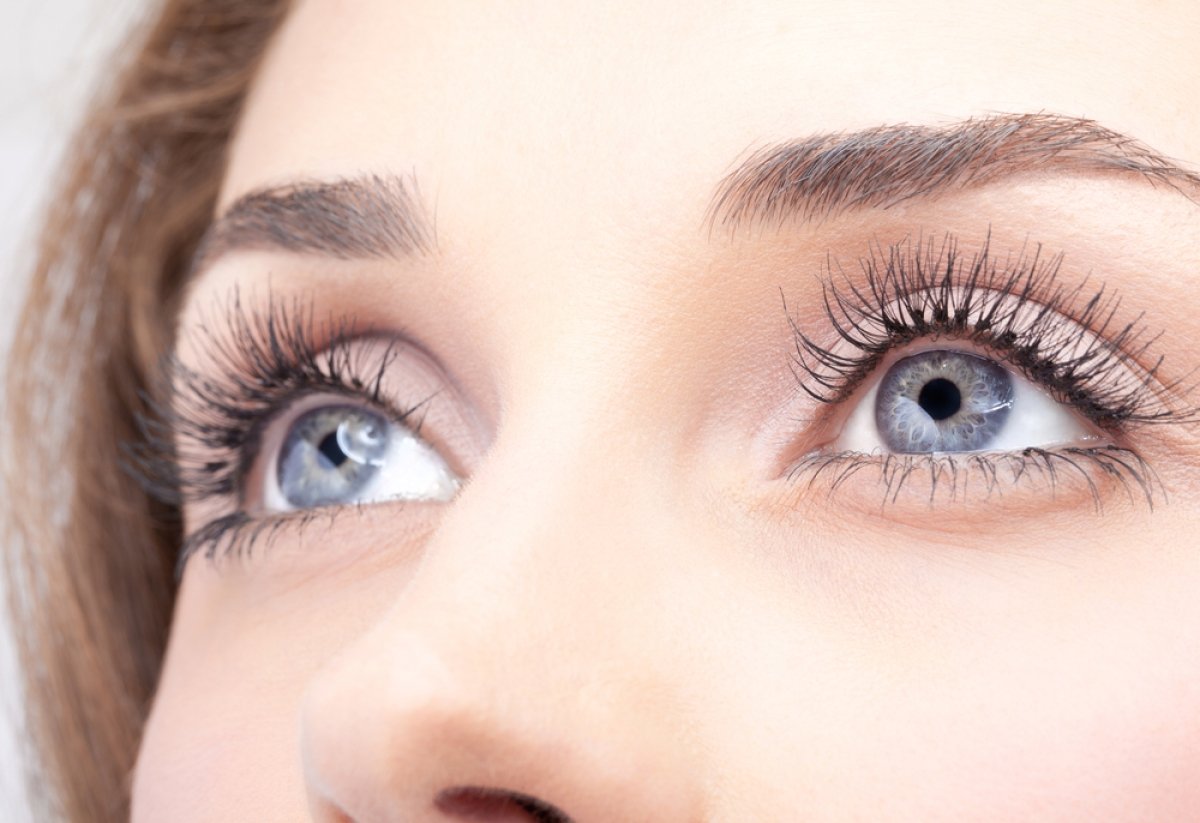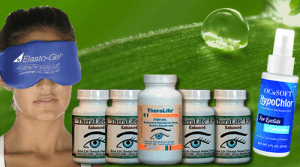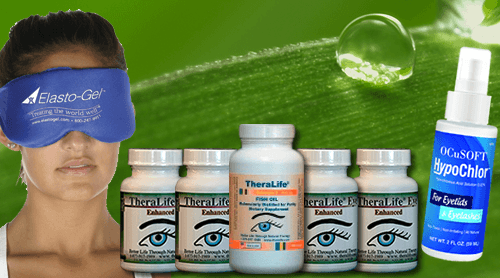TheraLife’s products aim to enhance tear flow and eye health by focusing on tear film stability and gland function. Their comprehensive approach to eye care is particularly beneficial for conditions such as blepharitis, dry eyes, and uveitis. TheraLife’s Eye Enhanced formula, for example, promotes meibomian gland activity, improving oil production and tear film consistency. This formula contains a blend of omega-3 fatty acids and essential vitamins that reduce inflammation and enhance tear quality, directly impacting eye health.
Their products also emphasize proper hydration and nutritional intake to ensure optimal tear composition. For those experiencing environmental challenges, TheraLife suggests adjustments like using humidifiers to manage tear evaporation and maintain eye moisture balance. Additionally, their resources provide guidance on eyelid care and massage techniques to prevent blockages and support meibomian oil flow.
TheraLife’s holistic treatment strategies extend beyond just products, offering dietary advice and lifestyle tips that further contribute to eye health. By combining these methods, TheraLife products collectively promote tear health and provide relief for various eye conditions, thereby improving quality of life for their customers.
Best All Natural Oral Treatment To Increase Tear Flow- TheraLife
Add To Cart
Key Takeaways
- Warm compresses improve gland function and stabilize tear film, enhancing tear flow.
- Omega-3 fatty acids reduce inflammation and enhance tear quality for better eye health.
- Adequate hydration maintains tear composition and prevents dry eye conditions.
- Humidifiers maintain air moisture, reducing tear evaporation and alleviating dry eye symptoms.
- Lifestyle changes, including exercise and stress management, support optimal tear production.
Warm Compress Benefits
Warm compresses can considerably enhance tear flow by improving the function of the meibomian glands. Applying heat opens these oil glands, increasing oil production and stabilizing the tear film. This process effectively slows tear evaporation, essential for maintaining eye moisture and reducing symptoms like dryness and irritation. The benefits of warm compresses extend to eye health improvement by alleviating discomfort such as burning or itchiness and enhancing tear quality. Additionally, the applied warmth boosts blood flow, which can help reduce swelling and loosen debris, facilitating the expulsion of bacteria. Regular use of warm compresses can also be combined with gentle eyelid massage to enhance the effectiveness in opening blocked glands. By stabilizing the tear film, warm compresses can also improve vision clarity. For ideal results, guarantee proper application techniques and consult an eye doctor to tailor treatment to your needs. Regular use of warm compresses can help open and unclog the meibomian glands, which are essential for maintaining a healthy tear film and overall eye comfort.
Omega-3 and Eye Health
Omega-3 fatty acids play an essential role in supporting eye health by reducing inflammation and enhancing tear quality. They can lower the risk of eye diseases like high eye pressure and macular degeneration. Incorporating omega 3 sources such as fish oil, flaxseeds, and walnuts into your diet can be beneficial. Omega-3s are key components of cell membranes, and high DHA levels are found in the retina, brain, and sperm cells, further emphasizing their importance in maintaining ocular health. An appropriate omega 3 dosage may also alleviate dry eye symptoms and improve tear film stability.
- Omega-3 supplementation reduces meibomian gland dysfunction (MGD), enhancing tear secretion.
- Oral omega-3s improve tear osmolarity and tear break-up time (TBUT), leading to better ocular surface health.
- They lower Ocular Surface Disease Index (OSDI) scores, indicating reduced inflammation and dryness.
- Some studies have shown that omega-3 fatty acids, particularly EPA and DHA, may assist in improving the symptoms of dry eyes, although more research is needed.
Regular omega-3 intake supports overall ocular health, making it a crucial component of eye care.
Hydration’s Role in Tears
Although often overlooked, proper hydration is essential for maintaining the composition and function of tears. Tears consist primarily of water, and dehydration can reduce both their quantity and quality. Ensuring a balanced salt concentration in tears prevents irritation. Dehydration negatively impacts blood flow and tear production in the eyes, increasing the risk of dry eye syndrome. Aging and hormonal changes can also contribute to reduced tear production, further highlighting the importance of adequate hydration.
| Hydration Importance | Hydration Tips | Eye Health Impact |
|---|---|---|
| Supports tear flow | Drink 8 cups daily | Prevents dry eyes |
| Balances salt levels | Consume hydrating foods | Reduces irritation |
| Maintains moisture | Steady hydration | Alleviates discomfort |
Adequate hydration keeps your eyes’ surface moist and lubricated, reducing symptoms like dryness and blurred vision. Regular hydration guards against dry eye disease and other ocular issues, including glaucoma and cataracts. To boost hydration, incorporate hydrating foods and avoid dehydrating beverages. Remember, slow and steady hydration throughout the day is key.
Eyelid Care Techniques
Maintaining eye hydration lays the foundation for effective eyelid care techniques, vital for managing tear flow. Incorporating lid hygiene and massage techniques can greatly enhance tear film stability. Start with regular lid hygiene, using mild soap to clean your eyelids and lashes, preventing blockages. Follow this with massage techniques: gently roll your finger upward on the lower lid and downward on the upper lid, performed twice daily during acute phases. Posterior blepharitis often leads to dry eyes due to dysfunction of oil-secreting glands.
A significant number of dry eye cases involve an evaporative component, making these eyelid care techniques particularly beneficial.
- Warm Compresses: Apply a warm compress for 2-10 minutes to boost meibomian oil production.
- Combination Therapy: Use artificial tears post-massage to clean away excess oils.
- Regular Assessment: Modify treatments as needed for ideal results.
These consistent practices are essential for improving tear flow and mitigating dry eye symptoms.
Environmental Adjustments
To effectively manage tear flow, consider using humidifiers to maintain adequate moisture levels, particularly in low humidity environments, as they can reduce tear evaporation and improve tear film stability. Implement regular screen breaks to alleviate digital eye strain, which can exacerbate dry eye symptoms by reducing blink rate and increasing tear evaporation. Guarantee proper ventilation and humidity balance in your indoor spaces to optimize air quality and maintain tear film integrity, as these adjustments can greatly impact ocular surface health. Utilizing a hot compress can aid in alleviating dry and irritated eye symptoms by improving gland function and enhancing overall eye comfort. Balancing the elements of water and air within your environment can also promote healthier tear production by providing the necessary moisture and reducing irritation from dry air.
Humidifiers for Moisture Maintenance
When managing tear flow and maintaining environmental moisture, humidifiers offer an effective solution. Selecting the right humidifier type is essential for ideal humidity control. Choose from:
- Bypass and Fan-Powered Humidifiers: These integrate with HVAC systems, enhancing moisture distribution.
- Flow-Through Humidifiers: They provide moisture without standing water, minimizing mold risk.
- Steam Humidifiers: These units use steam to effectively increase air humidity.
Humidifiers can improve skin health, offer respiratory relief, and alleviate allergies. Ensuring that the humidity level stays within the ideal range of 30-50% is crucial to avoid discomfort or mold growth. Guarantee regular maintenance to prevent issues like mold growth and mineral build-up. Clean water reservoirs and inspect filters frequently. Employing distilled water can reduce mineral deposits. By maintaining proper humidity, you can also support normal function of the meibomian oil glands, which is vital for eye health.
Over-humidification poses health risks, so monitor humidity levels closely. Regular maintenance and proper usage guarantee your humidifier aids in tear flow management effectively.
Screen Breaks for Relief
Humidifiers effectively support tear flow by maintaining ideal air moisture, yet managing digital eye strain requires additional strategies. Reducing screen time through frequent breaks can alleviate eye strain. Implement the 20-20-20 rule: every 20 minutes, take a 20-second break to look 20 feet away. Scheduled breaks are essential for eye health, as 60% of individuals spend 5-6 hours daily on phone screens. Schedule longer breaks every 30 minutes to stretch and walk. Conscious blinking exercises during these intervals help spread the tear film evenly. Optimize screen positioning by maintaining a distance of 20-30 inches, aligning the top of the screen at or below eye level. Avoid tilting the screen towards your face to minimize glare. Use proper lighting, such as soft, indirect light, and consider blue light filters to further reduce strain and enhance tear production. Addressing chronic dry eyes with effective management strategies can significantly improve comfort and reduce the risk of complications like blepharitis.
Ventilation and Humidity Balance
While it mightn’t always be top of mind, maintaining proper ventilation and humidity levels greatly affects tear flow and eye health. Implementing effective ventilation strategies can mitigate the impact of airborne particles and pollutants that compromise tear film stability. Poor indoor air quality exacerbates dry eye symptoms, so ensuring adequate airflow is essential. Tear film instability is associated with various factors including environmental and external factors. Humidity control plays a pivotal role in tear film evaporation. Low humidity environments increase evaporation, leading to dryness, while higher humidity can stabilize the tear film. In regions with high UV exposure, protective measures like sunglasses are important to complement environmental adjustments. To enhance your environment:
- Use air purifiers: Reduce particulate matter and improve air quality.
- Introduce humidifiers: Maintain ideal humidity levels to alleviate dry eye.
- Regularly open windows: Enhance ventilation and reduce indoor pollutants.
These adjustments can appreciably improve tear health and comfort.
Nutrition’s Impact on Tears
Although often overlooked, nutrition plays a pivotal role in maintaining healthy tear production and function. Key nutrient sources include dietary proteins and essential vitamins like A, B6, and C, which are essential for tear health. A dietary balance is necessary; deficiencies in these nutrients can lead to tear dysfunction. Potassium and zinc are necessary for normal tear function, while omega-3 fatty acids, found in fish oil, reduce inflammation and support tear film stability. Consuming a balanced diet contributes to overall health and rehabilitation success. The Eye Autoimmune Formula contains immuno-modulators and anti-inflammatory agents that help regulate the immune system and minimize flare-ups. Conversely, excesses of fats, salt, and refined sugars can lead to inflammation and exacerbate dry eye conditions. Adequate hydration is critical, as dehydration elevates tear osmolarity. Maintaining lipid balance is essential, especially given the link between hyperlipidemia and dry eye disease.
Lifestyle Changes for Tear Flow
Ensuring ideal tear flow requires making strategic lifestyle changes that address hydration, environmental factors, and screen time habits. Regular exercise benefits tear flow by enhancing circulation and reducing stress. Stress management is essential; high stress can exacerbate dry eye symptoms. Staying hydrated is critical; aim for eight glasses of water daily to support tear production. Maintain a diet rich in omega-3 fatty acids to promote eye health and support tear production. Avoid excessive caffeine and alcohol, as they dehydrate, worsening dryness. Adequate hydration is a foundational aspect of dry eye treatment, and monitoring fluid intake can effectively manage dry eye conditions. Enhance your environment by using a humidifier and wearing sunglasses outdoors to shield eyes from harsh elements.
- Follow the 20-20-20 rule: Take breaks every 20 minutes to look at something 20 feet away for 20 seconds.
- Blink regularly during screen time: It maintains tear flow and reduces dryness.
- Consult eye care professionals: Tailor lifestyle changes for best results.
Frequently Asked Questions
How Long Does It Take for Natural Remedies to Show Results?
When you’re using natural remedies, the timeline for expected results varies. Immediate effects, like warm compresses, can provide relief in days.
Short-term results, such as increased tear production from hydration, might take weeks.
Long-term improvements, like those from omega-3 supplements, could take months.
Remember, factors like the severity of the blockage and treatment consistency affect the outcome.
Some cases might need medical intervention if natural remedies aren’t effective.
Can Natural Remedies Replace Artificial Tears Completely?
Can natural remedies replace artificial tears completely? Imagine the possibility of solely relying on natural alternatives for your eye health.
While hydration, omega-3s, and dietary adjustments offer promising benefits, they mightn’t fully substitute artificial tears, especially in severe cases.
The variability in effectiveness and need for consistency make complete replacement challenging.
Combining both can optimize results, but always consult an eye care professional to tailor the best approach for your needs.
Are There Side Effects of Using Natural Remedies for Tear Production?
When using natural remedies for tear production, consider the side effects.
Natural ingredients can cause potential allergies or irritations, especially with new foods or supplements. Overuse of omega-3 can lead to gastrointestinal issues and interact with medications.
Incorrect humidifier use may increase mold exposure, worsening respiratory problems.
Always monitor symptoms and consult an eye care specialist to balance benefits and risks, ensuring safety with these remedies.
How Do Genetics Affect Tear Production and Natural Remedies’ Effectiveness?
Imagine your genetics as the blueprint of a house, where genetic predisposition determines the architecture of tear gland functionality.
Like a finely tuned machine, your tear glands may falter if genetic variations disrupt their balance. Studies show these genetic factors can sway how well natural remedies work.
For instance, genetic predispositions may cause tear film imbalance, directly impacting the effectiveness of treatments like omega-3 supplements or warm compresses.
Can Natural Remedies Help With Severe Dry Eye Conditions?
You can effectively manage severe dry eye conditions with natural remedies like herbal supplements and dietary changes.
Clinical evidence supports omega-3 fatty acids from fish oil as they reduce inflammation and improve tear production.
Adequate hydration and a nutrient-rich diet enhance ocular health, while avoiding irritants aids symptom relief.
Additionally, warm compresses and eyelid massages promote tear flow.
These methods, backed by research, offer a thorough approach to alleviate dry eye symptoms.
Best All Natural Oral Treatment To Increase Tear Flow- TheraLife
Add To Cart
Conclusion
Theralife’s products offer a comprehensive approach to boosting tear flow and improving eye health. By utilizing their specialized supplements and treatments, customers can effectively manage conditions like blepharitis, dry eyes, and uveitis, among others. The products emphasize natural remedies, such as Omega-3 supplementation and anti-inflammatory diets, which enhance overall ocular health. Additionally, Theralife provides guidance on eyelid care, environmental adjustments, and lifestyle changes to support sustained eye health. Just as a symphony requires each instrument, Theralife’s solutions integrate these elements harmoniously, ensuring tears flow effortlessly and effectively for their customers.





